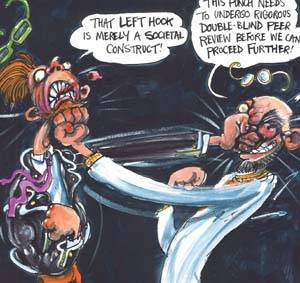This article is a preview from the Summer 2019 edition of New Humanist
If you’re sick of politicians citing the Second World War in their stance on Brexit, standing in a room of the most famous British military propaganda posters from the era will prove a powerful cure. Abram Games is celebrated now as a genius of mid-century design; most famously his branding of the Festival of Britain – that elegant profile of the goddess Britannia – but also his images of British brands that encapsulate post-war confidence, from the British Overseas Airways Corporation to the Financial Times.
His wartime posters, on display at the National Army Museum in London until November, remind us of a remarkable moment when an individual could come up with a powerful idea and get the creative freedom to achieve it. Games, a conscripted infantryman, convinced the army to let him run his own department, generating his own ideas of what soldiers needed to know. Though he had some art school training, Games, the son of Jewish refugees, had an instinct for applying his visual talent to social welfare.
Most of his work would have been displayed on small posters around mess rooms and barracks. His distinctive airbrush compositions, infused with the imagery and techniques of surrealism and Bauhaus, tackled everything from brushing your teeth correctly to keeping your ammunition dry. Part of their power is his unashamed use of glamour to inspire. His original recruitment poster for the the Auxiliary Territorial Service (ATS) was trying to attract middle-class women to a service that involved much grit and grease. The exhibition curator, Emma Mawdsley, tells with pride and delight how her own mother – then just 17 – was one of those who signed up because of it.
But there’s a tension in Games’s work: it is hard to imagine it getting permission now. His elegant women and handsome male soldier profiles are almost without exception facing left – a surprisingly obvious statement of his socialism. It makes the glamour of his figures all the more provocative. That ATS poster and some others were withdrawn after their initial release. In the case of the glamorous ATS woman it was because of her implied brazenness. The siren-red lipstick triggered questions in Parliament.
Games’s posters do not flinch from harsh messages, for instance coffins to show that children will die from carelessly uncleared unexploded ammunition. His non-army fundraising posters for Jewish refugees use skeletal imagery of survivors of concentration camps. Such imagery would no doubt be considered intrusive now.
Above all, they celebrate the military and a broader socialist covenant between government and state that was considered mainstream in the 1940s and 1950s. Soldiers were confronted with images encouraging them to consider a further professional career with the army with its camaraderie, or to take advantage of training and apprenticeships to forge a new life on Civvy Street. His 1942 series “Your Britain: Fight for it Now” used images of the new designs of colleges, health centres and council estates to show the new Britain being planned and built.
One poster that was withdrawn shows behind the façade of the new Finsbury Health Centre in London. It depicts a child with rickets, the word “disease” graffitied onto a crumbling wall. Admitting such a Britain existed at all – even if it was being rapidly changed as the NHS took root – was unacceptable, according to then Prime Minister Winston Churchill. But these occasional bans remind us how strong his messages were.
What’s particularly affecting, seeing Games’s wartime posters now, is an awareness of how dramatically the covenant has broken down. During and in the aftermath of the Iraq War, stories of the poor treatment of British soldiers began to get more and more news coverage. There were scandals of poor or faulty equipment – soldiers without the right body armour; soldiers who weren’t getting proper treatment and therapy for their life-changing injuries or post-traumatic stress.
Under David Cameron’s coalition government, problems were compounded by massive cuts in jobs and an increasing reliance on the Territorial Army. One wonders what Games would make of the headlines about ex-army homelessness, mental ill-health, private company-run assessments withdrawing benefits from those left with severe disabilities, or the growing number of suicides. Or about the closures of libraries and youth and Sure Start centres.
Games’s posters were a promise of a better future predicated on a shared civic state. To modern eyes they have a more dreamlike quality than ever.

